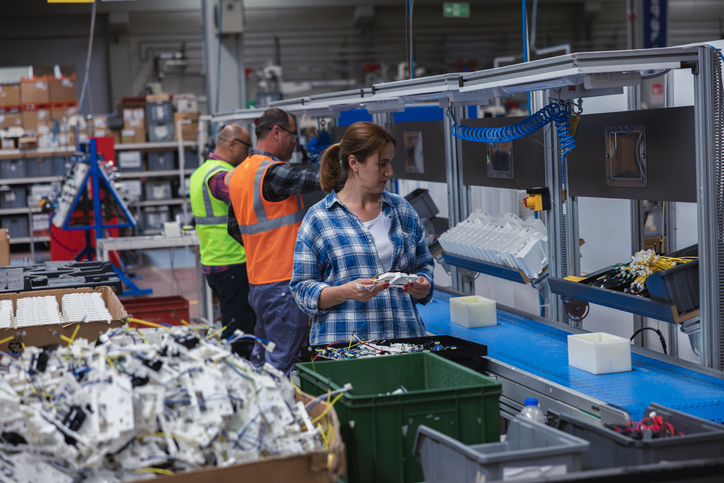For Industrial Equipment Manufacturing (IEM) companies, unique industry challenges can stall the best laid plans, putting their competitive edge in jeopardy. From production processes and priorities, to getting access to real-time data IEMs must overcome obstacles that stand in the way of efficiency and profitability.
In this post, we’ll explore 7 common industrial manufacturing challenges and how modern ERP could make all the difference. By leveraging digital tools and streamlined workflows in the production environment, manufacturers can establish more efficient production processes and secure their competitive advantage.

How ERP Solves Discrete Manufacturing Challenges
Download this eBook to discover how modern ERP systems can revolutionize the way discrete manufacturers operate.
IEM Challenge #1: Making the decision on low-volume/high-dollar engineered-to-order projects with limited historical data
When it comes to making decisions about low-volume, high dollar engineered-to-order projects, IEM companies who lack historical data may struggle to justify these contracts. Without an accurate historical basis for forecasting costs, timelines and potential issues they face the risks of underpricing or overextending their capabilities. Plus, the lack of data insights can impede the ability to identify best practices to improve efficiency and prevent financial loss or project delays.
Solution: Modern ERP solutions enable informed decisions with advanced business intelligence capabilities, which can be used to identify similar ETO projects, and to analyze costs, compare estimated vs. actual variance and determine opportunities for improving efficiency.
IEM Challenge #2: Accurate, real-time cost analysis of complex projects when the designs and processes are in flux
If designs are frequently changing, industrial manufacturing companies can struggle with formulating accurate cost analysis for complex projects. Whether due to customer changes, regulation updates or technical issues, project changes make it difficult to maintain accurate financial estimates.
Any discrepancy between projected and actual costs can lead to budget overruns. Plus, without real-time visibility into how these changes effect expected costs, manufacturing businesses might be challenged to make informed decisions about profitability.
Solution: ERP systems capture costs for engineering, project management, direct labor and other components within each project—and all cost data resides within a single system. This consolidation enables on-the-fly analysis.

IEM Challenge #3: Managing production when designs are incomplete or changing
Incomplete designs can lead to significant challenges in managing production lines. They can lead to shop floor confusion, impacting resource allocation and scheduling. Plus, design changes can impact inventory control and throw a wrench into workflows, effecting efficient production processes and causing delays. If parts intended for one design are no longer needed or require modifications, the business make incur higher costs from wasted materials or more labor.
Solution: Advanced engineering change management processes can be deployed to enable the ability to procure and build long-lead-time parts while simultaneously introducing frequent design updates from the CAD-to-ERP system. In addition, modern ERP systems can better facilitate communication across teams, ensuring that production can swiftly adapt leading to more efficient operations.
IEM Challenge #4: Managing production priorities
With multiple engineered-to-order projects running simultaneously, IEM companies often face challenges in managing production priorities. Without a centralized system for tracking and prioritizing projects, shifting project deadlines, resource availability and customer requirements can complicate scheduling and lead to bottlenecks in production.
Solution: ERP systems integrate project management and material requirements planning into one hybrid planning system. Information is efficiently shared and fed between the project management and supply chain functions throughout each project’s lifecycle.

IEM Challenge #5: Mitigating the risk of part obsolescence
With the rapid pace of technological advancements and customer needs, the risk of part obsolescence moves to the forefront. As equipment designs change, once-critical components become outdated or incompatible leading to disruptions in production and rising costs affecting manufacturers.
Supply chain lead times for sourcing custom parts and the nature of engineered-to-order projects can result in project delays and budget overruns. Plus, inventory management of obsolete parts can lead to overstocks and higher carrying costs, while insufficient inventory may cause production interruptions.
Solution: The Product Lifecycle Management (PLM) functionality within ERP system provides visibility when critical materials used in production and installed in machines in the field are being phased-out. Also, digital transformation can help manufacturers better manage supplier relationships and facilitate demand forecasting to prevent supply chain disruption.
Ready to start your digital transformation journey?
IEM Challenge #6: Creating a production schedule that considers setup optimization and the nesting (grouping) of similar parts
Another common challenge affecting many manufacturers is the ability to create production schedules that consider optimization through nesting or grouping of similar parts. With parts requiring distinct setup and processing, there can be significant downtime between runs. But by investing in new technologies, production runs can be shortened, maximizing efficiency and minimizing setup times.
Solution: ERP systems provide the ability to optimize setup times by scheduling similar part families based on their attributes, and to sequence the product families in an order that minimizes the time a machine is down for setup and maximizes the time it is up running. Utilizing modern ERP systems can facilitate better planning by analyzing production requirements, lead times, and machine availability.
IEM Challenge #7: Integrating manufacturing, engineering and project management to create a strategic advantage
One of the top industrial manufacturing challenges is to effectively integrate manufacturing, engineering, and project management. For many manufacturing organizations, these departments operate in silos leading to communication gaps and inefficiency.
For example, if engineering teams design products without alignment with manufacturing capabilities or project timelines, it can result in rising costs from redesigns or production delays. Plus, without collaboration, project managers may lack insight into production capabilities and engineering constraints, increasing the difficulty of creating accurate schedules and allocating resources.
Solution: Advanced technologies, like modern ERP, can tightly connect these functions and integrate production, design and process data to identify and enable new efficiencies, shorten cycle times, accelerate manufacturing processes, and ensure on-time/on-budget performance. By breaking down siloed communication, manufacturers can add more visibility into the project, streamline manufacturing operations and quickly respond to changes. Taking this holistic approach helps a manufacturing business improve efficiency and reduce costs while increasing customer satisfaction, ultimately creating a competitive advantage in the market.
Conclusion
Challenges abound across the manufacturing sector. For IEM manufacturers, these manufacturing industry challenges can jeopardize efficiency and profitability. From managing incomplete designs and fluctuating production priorities to mitigating the risks of part obsolescence, these obstacles can stall even the best-laid plans. However, by embracing smart factory solutions including modern ERP solutions, IEMs can transform these challenges into opportunities for business growth and improvement.
Are you experiencing any of these industrial manufacturing challenges? Ultra can help! Everyday our experienced team brings innovative solutions to the challenges the manufacturing industry faces. From supply chain disruptions and rising raw materials cost, to a tight labor market and the need for sustainable practices, Ultra can show you how modern technology and improved business processes can make a difference. Request your free initial consultation to learn more about setting the stage for successful digital transformation.






